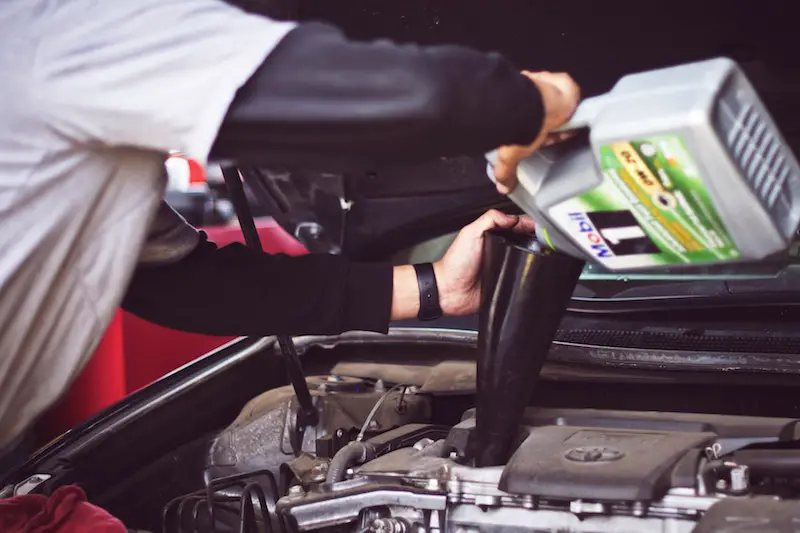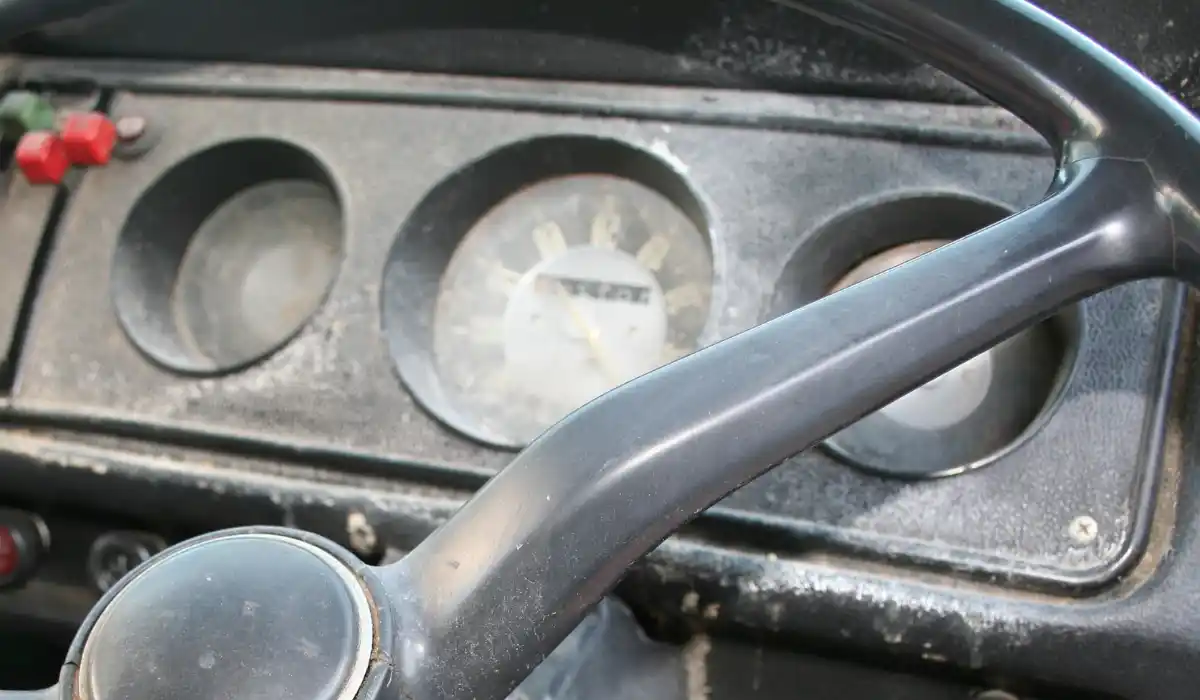
Oil changes are one of those aspects of essential car maintenance you don’t want to miss. If you’re doing your own oil changes at home, there are a few different items you can use to make the process easier.
One of these items is an oil drain pan. Changing your oil without one usually results in a messy experience and a long cleanup.
By using the best oil drain pan you can find, oil changes become easier, more efficient, and less messy. In this post, we’ll be going over our recommendations for oil pans you should be using.
Afterwards, we put together a healthful buying guide and FAQ that should cover any of your concerns through the buying process. With that in mind, let’s jump right into it!
Jump Ahead To:
The Best Oil Drain Pan
ATD Tools Black Drain Pan (Best Oil Drain Pan Overall)

Our top recommendation for the best oil drain pan is the ATD Tools Black Drain Pan. This is a simple, lightweight drain pan that helps to simplify your oil changing experience.
Thanks to the huge opening at the top, there’s not as much concern when it comes to oil draining accuracy. As long as you have the pan in the right general area, the oil is going to drain right into it.
Afterwards, it’s just as easy to move the oil around and get rid of it. This pan comes equipped with large, built-in handles that allow you to keep it balanced, even when it’s full of oil.
As for disposal, the built-in spout provides an effortless experience for pouring oil into a disposal container. Simply hold it in your hands, pour it in at the right angle, and you’re all set.
It even comes equipped with an anti-splash lip. This way you don’t have to worry as much about oil splashing on to your garage floor, driveway, or clothes.
Despite the simple, no frills design, the ATD Tools Black Drain Pan stands as one of the best oil drain pans for most people. It’s easy to use, reasonably priced, and great for doing your own oil changes at home.
Hopkins FloTool 16 Quart Super Duty Drain Container

The Hopkins FloTool 16 Quart Super Duty Drain Container is a great choice if you’re looking for a self contained drain pan. This one features an enclosed design and leak-proof design for secure storage and easy disposal.
Unlike our first recommendation, which has a large top opening, this container allows the oil to drain into an enclosed section. It takes advantage of an extended design that captures the full stream of oil while preventing overflow and splashing.
After the oil is drained on to the pan, it continues draining into the container. With a 16-quart capacity it’s possible to perform more than one oil change before having to worry about disposal.
When it comes to disposal, this container has a disposal spout. To help prevent leaks, heavy duty caps and seals are used.
Thanks to the robust handles, transporting this container for disposal is easy. When it’s time, remove the cap and tip the container for the oil to drain into another proper disposal container.
If you’re looking for an enclosed draining solution, it’s the Hopkins FloTool 16 Quart Super Duty Drain Container that we recommend. The elongated basin, leak-proof design, and durable handles make this a great choice for DIY oil changes.
Hopkins FloTool 5-Gallon Open Top Drain Pan (Best Cheap Oil Drain Pan)

The Hopkins FloTool 5-Gallon Open Top Drain Pan is another great choice if you’re looking for a cheap oil drain pan. You like this one because it comes with a fluid drain, handle, and an oversized lip.
The 5-gallon capacity is great for doing more than one oil change. There’s no lid, but you could cover it on your own and leave the oil inside until you’re ready for disposal.
It’s easy to use this drain pan and manoeuvre it thanks to the handle. Pouring oil out is easy as well with the built-in spout.
The oversized lip helps to contain splatters and prevents oil from splashing on your clothes or garage floor. This makes it ideal for easy, clean, and no-fuss oil changes.
Finally, the lightweight plastic design makes it easier to manage when it’s full of oil. There’s no struggling or awkwardly dragging the pan when you’re ready for disposal.
Overall, the Hopkins FloTool 5-Gallon Open Top Drain Pan is a great choice if you’re looking for a budget oil pan. This one is nearly perfect thanks to the oversized lip, handle, and pouring spout.
Performance Tool Galvanized Drain Pan

Those of you on a budget looking for something simple will want to check out the Performance Tool Galvanized Drain Pan. This is a no-frills, basic pan that’s ideal for those looking for simplicity.
Depending on your requirements, there are drain pans from this set ranging in size from 1.75-gallons up to 7.5-gallons. Most people will find the 3.5-gallon pan to be suitable for a single oil change.
The drain pan itself takes advantage of a simple design. It’s made from galvanized steel and durable enough for regular use.
Unfortunately, this pan doesn’t come with any handles or a pouring spout. If you’re doing the oil changes in your garage or on a flat surface, it probably won’t be an issue when it comes time to disposal.
Some people have mentioned that the pan isn’t wide enough with its 16-inch diameter. Setting it up properly under the oil drain plug on your vehicle should help you avoid any problems with its width.
Overall, if you’re looking for a cheap and basic oil drain pan, it’s the Performance Tool Galvanized Drain Pan that we would recommend. This is a simple solution for doing affordable at home oil changes.
Midwest Can Company Closed Top Drain Pan

The Midwest Can Company Closed Top Drain Pan is designed to contain the oil after it has been drained from your vehicle. This is a great choice if you’re not able to dispose of the oil right away or you want it covered after finishing the oil change.
The pan itself is made from a durable, high-density polyethylene plastic. This results in a lightweight, portable design that makes it easy to use.
All of the oil flows into the catch basin at the top. From here it drains into the bottom part of the pan through two drain holes. This section remains covered until it’s time for disposal.
When it comes to disposal, there is a drain on the front of the pan. Simply unscrew the drain lid and pouring out the oil is a breeze.
There aren’t any handles, although the large sides are easy to grip. Thanks to the lightweight design, there shouldn’t be any issues moving the pan around your garage.
The Midwest Can Company Closed Top Drain Pan is a great choice if you’re looking for an affordable, covered pan. It’s ideal for multiple oil changes and easier disposal.
Best Oil Drain Pan Buyers Guide

At this point, you’ve gotten a good look at our recommendations for the best drain pans. Hopefully you have found something suitable for your at home oil change requirements.
If you’re still having trouble deciding, we put together this helpful buyer’s guide. It can be tricky finding the right model with so many different features, designs, and other aspects to consider.
After reading this guide you should be well-equipped at choosing the right pan. If you still have any questions, don’t hesitate to let us know in the comments.
Features to Look For When Buying an Oil Drain Pan
Each oil pan is designed with different features and options. Here are some of the different features to consider when you’re in the market for something new.
Pouring Spout
Pouring spouts make it easy to dispose of any leftover oil from your oil change. Without one, it can be difficult and messy to dispose of the oil.
Depending on the pan, it should come equipped with either an open or covered oil spout. This isn’t a necessary feature, although it’s good to have for easy disposal.
Open spouts typically come with the open-style design. Closed spouts typically come with the style that keeps the oil enclosed.
Storage
Depending on the pan, some come with storage while others have an open-air design. Choosing the style will depend on how you’re disposing of the oil.
With the built-in storage compartments the oil drains straight into the pan. Once you’re done, it can be covered, and easily disposed of. With this design, it’s also possible to use the same pan for multiple oil changes.
For the open style, the oil drains directly into the pan with no covering. This would need immediate disposal, otherwise the oil will be sitting and exposed to the environment. With this style, it’s a good idea to find one with a spout for easy disposal.
Handles
Handles make moving the pan and disposing the oil a lot more manageable. After an oil change, you might be surprised by how much all of that liquid weighs.
With a handle it’s easy to move the pan, whether it’s empty or full. It’s also easier to tip it over to pour the oil into another container or get rid of it for disposal.
Size
The size of the pan is another factor worth considering. Choosing the right size depends on how many oil changes you’re planning to do at a time.
Smaller pans can be used for one and sometimes up to two oil changes before they’re full. Larger pans can be used for a few different oil changes before it’s time for disposal.
Keep in mind that the larger pans will be heavier when they’re full. This makes them more difficult to move and harder to deal with.
Do You Really Need an Oil Catch Pan?

Yes, it’s important that you use an oil pan for a few different reasons. Without one, it’s difficult to contain the oil properly.
Not only can this be messy, it can be damaging to the environment. let’s Take a look at some of the benefits of using this product for any of your oil changes.
Easy Clean Up
Cleaning up oil spills, whether it’s in your garage or on the driveway, is time consuming and expensive. It’s difficult to remove oil stains from concrete, asphalt, and other driveway or garage floor materials.
This can result in permanent, unsightly stains. In many cases the stains will never go away, they’ll only fade over and remain as a reminder of your mistake.
With an oil pan, this is a problem you can easily avoid. Using one for your oil changes means you won’t have to worry about removing stains from your driveway or garage floor.
Less Chance of Spills
Another benefit is that oil pans are designed to contain the large quantity of oil that’s drained from vehicles. Car engines can hold up to 8 quarts, or more, and without the proper container you’re running the risk of spills or overflow.
Once this happens, you’re stuck with a permanently stained driveway or garage floor like we just mentioned. It’s easier to use the oil drain pan and avoid having to deal with these issues in the first place.
Easier Oil Changes
Draining the oil from your vehicle engine probably isn’t the most exciting way to spend your afternoon. Using the proper tools, such as a drain pan, can make the process faster and easier.
As long as you have the right equipment, there’s no reason you can’t get everything done in less than an hour. With experience and the right tools, you’ll be able to perform your own oil changes in under 30 minutes.
Oil Changes Are Necessary
Finally, whether you’re doing them at home or at a garage, oil changes are an essential part of car maintenance. Regardless of the car, it’s important that engine oil is refreshed on a regular basis, preferably following the vehicle maintenance schedule.
Oil helps to lubricate the engine components and keeps it running as smoothly as possible. This results in better performance, improved fuel consumption, and helps to prolong the lifespan of the engine.
To avoid any serious issues with your vehicle, oil changes are a must. If you’re going to be doing them at home, it’s a good idea to have the right tools to get the job done.
Engine Oil Leaks – What Causes Them?

It’s never a good sign if your engine is leaking oil. This is the lubrication that keeps the engine functioning properly.
Without it, expensive and permanent damage can occur. That’s why it’s a good idea to take any oil leaks seriously.
If the oil is leaking out of your vehicle, it’s not doing its job. Should you notice any leaks, check the level and act accordingly. You could choose to top it off or replace the old oil once you find the problem.
In most cases, there are five main causes of oil leaks. One of the following will likely be your issue, especially if you see a patch of oil underneath your car:
Old Oil Filter
Oil filters are a vehicle component that needs to be periodically replaced. Every time you do an oil change it’s a good idea to replace the oil filter.
Without replacing it, the filter can get clogged. This can result in an oil leak underneath your vehicle and could damage the engine.
Using clean oil and regularly replacing the oil filter will help to prolong the lifespan of your vehicle.
Check out our post on the best motorcycle oil filters for our recommendations! There’s also a post on finding the best motorcycle oil that you may find helpful.
Damaged Oil Pan
The oil pan is where the engine oil is contained on your vehicle. It’s positioned low down on the chassis of your car.
This makes it susceptible to damage from speed bumps, rocks, logs, and other debris on the road. If the oil pan is damaged, cracked, or broken in any way it will probably start leaking.
Damage to the oil pan can also damage the pan seal. This could also result in leaks.
Damaged Engine Gasket
Gaskets are seals that are found in the engine where any two metal components are connected. They are a consumable item and will degrade over time.
Once damaged, gaskets are no longer able to provide a complete seal. Without a proper seal, it’s possible that oil can start leaking out of the engine.
Old oil, especially when it gets dirty, corrodes gaskets at a higher rate. This makes oil leaks even more likely.
To avoid this issue, it’s a good idea to perform regular oil changes. This helps to prolong the lifespan of the gaskets and avoid any expensive replacements.
Damaged or Missing Oil Filler Cap
The oil filler cap covers the oil compartment. If it’s damaged or missing, it’s possible that oil can leak out.
When the engine is turned off, oil will drip out. While the engine is running, there will be a steady flow of leaking oil.
Regularly inspect the oil filler cap to make sure it’s present and not damaged, cracked, or broken. Should you notice that it’s missing or damaged, replace it immediately.
Damaged Oil Drain Pan Plug
The oil drain pan plug is a key component of the oil pan. It keeps the oil in place and prevents it from draining out of the pan.
If the plug is damaged, cracked, or broken in any way, this can result in an oil leak. A significant amount of dripping oil could be the result of a damaged plug.
Check that the plug is present, secure, and not damaged if you notice oil dripping from your engine. This could be an easy fix if it’s what happens to be your problem.
Check That Your Vehicle is Actually Leaking Oil
There are a lot of fluids that your vehicle uses. Rather than assuming you have an oil leak, it’s a good idea to verify before jumping to conclusions.
To the untrained eye, most leaking fluids will look pretty similar. To check what’s leaking, use a clean white cloth and soak up some of the fluid.
Look closely at the colour of the fluid. This will be the easiest way to determine what’s leaking from your vehicle. Here’s what you could be looking at:
- Red – This could be a fluid leak from the transmission or the power steering system.
- Orange – Orange fluid leaks from the transmission or a rusty radiator.
- Yellow – Yellow fluid would indicate a leak of your radiator coolant.
- Blue – This is probably windshield washer fluid and not something to be really concerned about.
- Green – Green fluid leaking could be indicative of an antifreeze leak.
- Brown – Light brown would indicate new (clean) engine oil leaking. Dark brown would indicate old (dirty) engine oil leaking.
- Clear – This would be a water leak. It’s probably condensation from the AC system and nothing to worry about.
It’s a good idea to diagnose any vehicle leaks as soon as you can. If you’re not able to determine where the leak is coming from, consider bringing your vehicle to your local mechanic.




